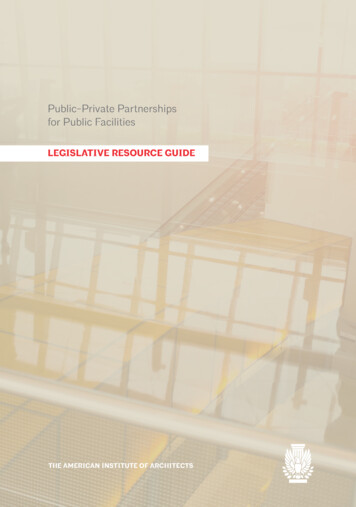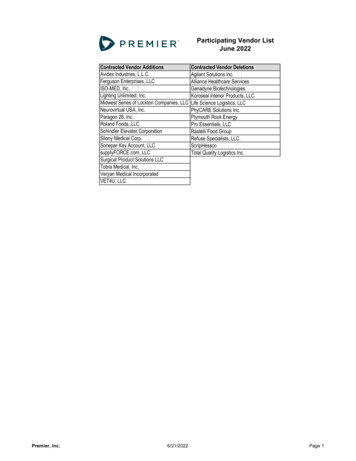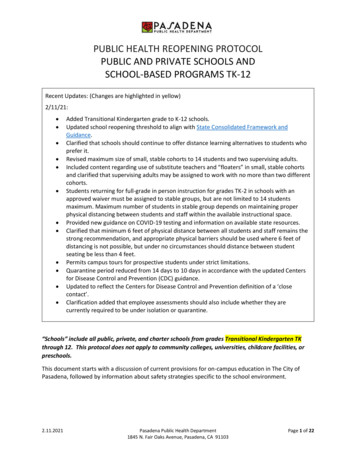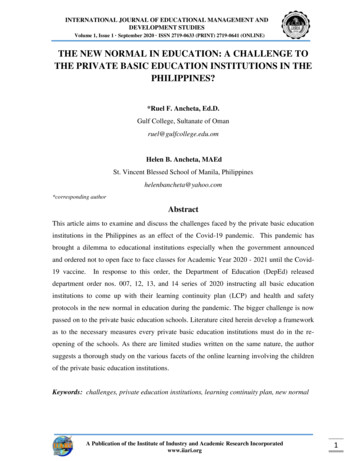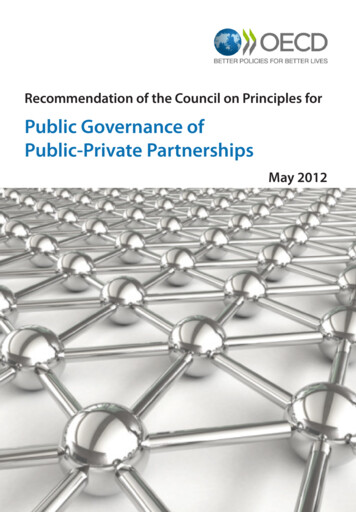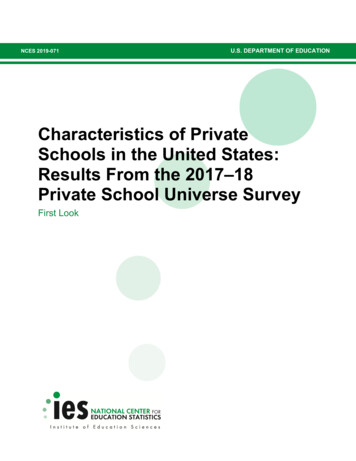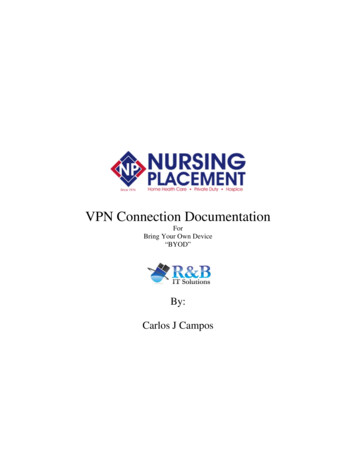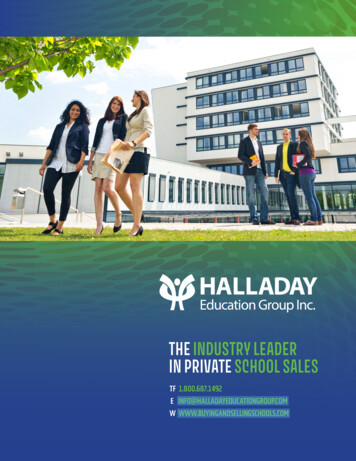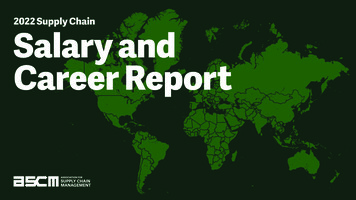
Transcription
International Journal of Humanities Social Sciences and Education (IJHSSE)Volume 4, Issue 2, February 2017, PP 100-111ISSN 2349-0373 (Print) & ISSN 2349-0381 10www.arcjournals.orgPublic Schools and Private Schools in Ethiopia: Partners inNational Development?Teshome Nekatibeb BegnaCenter for Comparative Education and Policy Studies, Addis Ababa University, EthiopiaAbstract: Ethiopia has given emphasis to the expansion of primary education to enhance the socio-economictransformation of its population. Because of its limitations to fund the expansion of the sector, however, thegovernment has introduced privatization as means to shift costs to users. Due to this, a dual system of educationhas grown in the nation. To ensure that both types of schools provide equivalent education, the government hasintroduced a primary school measurement standard. So far, no study has been carried out whether thesestandards are met and if schools provide equitable education. The purpose of this study was to fill this gap andanalyze whether public and private primary schools provide equitable education in Ethiopia. A multi-methodresearch approach with a case study and survey perspectives was adopted to conduct the study. A total of 68public and private schools were purposefully selected and 1,260 respondents participated in the study. Findingsindicate that learning in private schools leads to more academic achievements than in public schools.Moreover, public schools don’t meet the minimum quality standards required by the government. It wasindicated that private schools differ from public schools for making rigorous selection of students, admittingstudents with appropriate age from families having higher levels of education. As compared to public schools,private schools provide more access to classrooms and teachers, attractive work environment, sufficientfacilities, qualified teachers, enriched curricula and a school management focused on results. From thesefindings, it was implied that the government needs to upgrade public schools, keep an eye on irregular practicesin private schools and control the mutation of public schools into private institutions.Keywords: Public schools, private schools, national development, learning achievement, school effectiveness1. BACKGROUNDThe government of Ethiopia issued two policy documents titled the „Education and Training Policy‟and the „Education Sector Strategy‟ in 1994 in which it committed itself to achieve universal primaryeducation by 2015. The government made it clear that it would play a major role in the developmentof education by increasing the financing of the educational system through budget allocation. At thesame time, it has recognized that it won‟t be able to bear the costs of educational expansion alone.Thus, it proposed privatization as an option in the strategy document as follows:The participation of the community will be encouraged and enhanced in building schoolsand provision of furniture on a voluntary self-help basis. Private sector participation shallbe promoted in the provision of and assistance of educational service. Different costsharing mechanisms shall be studied and introduced particularly for beneficiaries ofhigher education (MOE: 1994a:13).After two decades of educational reforms following the above guideline, Ethiopia has developed adual system of education all along from preprimary to higher education. One is the public orgovernment sector while the other is the non-government or private sector. There are differentexpectations from the emerging private sector. For the government, privatization would bring aboutexpanded access towards the achievement of universal primary education. Simultaneously, it wouldshift away some of the financial burdens to users. For affording parents, opportunities for learningalone are not sufficient for their children and they require good quality education. This would meanqualified teachers, adequate facilities and learning materials, good learning environments, higherachievements in national examinations. They also need safe environments and equal treatments,particularly for their female children. Such parents are ready to pay a certain amount of fees in returnfor the services they are provided. As consumers, there is no doubt that they would like to also beconsulted about matters pertaining to their children‟s learning. ARCPage 100
Teshome Nekatibeb BegnaPrivate PublicTheoretically, demands on the public schools are similar to the private schools, but with minimum orno fees paid. To this end, the Ministry of Education (MOE) (2009) has provided a guideline tostandardize the operations of schools in Ethiopia. The purpose of the standard is to ensure equivalenceof learning conditions among all schools irrespective of whether they are urban or rural. It also appliesto both private and public schools.Ethiopia remained a predominantly rural country and about 86% of its population lives in rural areas.Thus, most primary schools are located in rural areas and MOE (2012/13) reported that 81% ofprimary school students are rural. Over the past two decades, the government has issued severalpolicy and planning documents having common visions to end poverty and move the country into amiddle-income economy by 2025 (AAU, 2008). The first five year plan (2010/11-2014/15),commonly known as the Growth and Transformation Plan (GTP), puts both rural, agricultural andindustrial transformation as important dimensions of the development strategy. According to Freemanand Mohamedbhai (2011:1), the GTP sets forth the national priorities as “ agriculture and ruraldevelopment, industry, infrastructure, social and human development, good governance anddemocratization.”While the GTP is strikingly ambitious, it is within this context that the revolutionary expansion ofeducation, improvement of its quality, equity and relevance draw their meaning. It is intended to serveall sectors by producing more highly qualified workforce that is demanded by industry, particularlythe growing manufacturing industry at all levels (Ministry of Finance and Economic Development,2012). The goal is to provide ample opportunities for learning and produce efficient and effective,knowledge based and innovative citizens who would contribute to the transformation process. Giventhe dual system, however, no study has been carried out how these different schools partner to equallyprovide services towards these goals under unequal circumstances. Thus, the question is to whatextent and how these systems contribute to the production of highly skilled citizens of equivalentquality in the transformation process. The purpose of this study is to explore the characteristics ofpublic and private primary schools in maintaining the standards for quality and equity of education inthe transformation process in Ethiopia. Our research questions revolve around three pillars: Dostudents in private and public school achieve equivalent academic results? Do private and publicschools provide equivalent opportunities to students in terms of gender, parental background,selection and admission? Do private and public schools work under similar conditions?2. OBJECTIVES AND SIGNIFICANCE OF THE STUDYThe overall objective of the study is to analyze the equity in standards of public and private primaryschools in the national development process in Ethiopia. The specific objectives of the study are thefollowing: To analyze student achievement both in private and public schools using the results of regionalprimary school leaving examinations. To investigate equality of opportunities to schooling in terms student selection, composition andparental background. To explore conditions under which both public and private primary schools operate in rural andurban contexts.International Journal of Humanities Social Sciences and Education (IJHSSE)Page 101
Public Schools and Private Schools in Ethiopia: Partners in National Development?The expansion of private schools as well as public schools in Ethiopia is very significant. In 2012/13,there were a total of 30,534 primary schools out of which 7% were private in the nation (MOE,2012/13). However, these dual systems are often perceived to have different standards. Usually it isclaimed that the standards of private primary schools are better than the public schools. Nevertheless,these claims and perceptions have not so far been studied and ascertained. Thus, this study willcontribute towards a better understanding of how these schools are faring in the process of nationaldevelopment.3. PUBLIC AND PRIVATE SCHOOLS: NATURE, PERFORMANCE AND CONDITIONS OF WORKThe variation of public and private schools has been discussed in various studies (see Arakelyan,2005, Bray, 1996, OECD, 2012, Kitaev,1999, Walberg and Burst, 2003). Commonly, these studiesagree that public schools are state or government schools mandated for or offered to all children bythe government. State education is inclusive and it is organized and operated by government agencies.Private education, on the other hand, refers to any type of formal school which is outside the publiceducation system (Kitaev,1999).The reasons for privatization are different in different countries, butdissatisfaction with the services provided by government institutions, access and coverage, quest forgood quality, profit- making and the need to reduce pressures upon existing schools are some of themajor rationales. Different forms of privatization are discussed in Arakelyan (2005), Bray (1996),andWalberg and Burst (2003), but Kitaev (1999) identifies five types of private education in Sub-SaharaAfrica: community, religious, spontaneous (bush), profit-making and expatriate private schools. Forthe purpose of this study, public schools refer to government primary schools whereas private schoolsrefer to all non-government primary schools.The performance of private and public schools has been a subject to analysis in a large number ofstudies (see Jimenez, Lockheed and Paqueo, 1991; NAEP, 2006; Bohlmark and Lindhal,2008;Dronkers and Robert, 2003). Most of these studies measure school performances usingacademic achievement in given subjects at a given grade/s. Results from these studies are similar.Students from private schools achieved more than students in public or government schools.Reports on the possible causes of differences in school effectiveness are enormous (see Sammons,Hillman and Morti more, 2000, Schreens and Bosker,1997, Teddle and Reynolds, 2000, Stockard andMayberry,1992, Dronkers and Robert, 2003, Temu, 1995).Typically these studies list variables thathave significant influence on students learning. More recently, an exhaustive review of literature bySammons, Hillman and Mortimore (2000) has summarized the following eleven main factors:professional leadership, shared vision and goals, learning environment, focus on teaching andlearning, purposeful teaching, high expectations, positive reinforcement, monitoring progress, pupilrights and responsibilities, home-school partnerships and learning organization.With particular reference to the possible conditions that explain the differences in effectivenessbetween public and private schools, a study by Dronkers and Robert (2003) included the followingconditions: differences in student characteristics and school composition, deliberate school choice,different conditions for teaching-learning and school administration, different school climates andstronger core curriculum. Similarly, Chanand Tan (2008) reviewed factors that influence theeffectiveness of private schools versus public schools from practice. They say that reputation ofacademic programs, school financial support systems, school size, class size, quality of teachers, levelof education, special needs education, student admissions, cost, support service, religious affiliation,location, demographic characteristics of students, governance, and teachers impact and perception arethe most important factors.4. HUMAN CAPITAL, MODERNIZATION AND SCHOOL EFFECTIVENESS PERSPECTIVESThe summaries of human capital and modernization theories as well as the criticisms of the twoapproaches are given in Fagerlind and Saha (1989). Accordingly, it is mentioned that human capitaltheory is rested on the assumption that formal education is highly instrumental and even necessary toimprove the production capacity or economic development of a population. In short, Fagerlind andShaha (1989) note that human capital theory argues that an educated population is a productivepopulation and it must be viewed not only as a productive investment, but also as a provider of skilledlabor force necessary for industrial and economic growth.According Fagerlind and Saha (1989), modernization is a sociological theory which argues that inorder for a society to become modern (to develop economically and socially), it must be composed ofInternational Journal of Humanities Social Sciences and Education (IJHSSE)Page 102
Teshome Nekatibeb Begnaa modern population, meaning having modern values, beliefs and behavior. For modernizationtheorists, there are causal links between five set of variables: modernizing institution, modern values,modern behaviors, modern society and economic development. Further, Fagerlind and Saha (1989)note that modernization perspectives assert that the creation of modern values can be the result ofhuman planning and that particular social institutions are of extreme importance for their emergence,for example, the socialization which takes place in families, schools and factories.Like human capital and modernization theories, school effectiveness studies are based on theassumption that school matters in students learning (scholastic achievement) as opposed to the viewthat home background matters more than schools (see Temu, 1995). However, school effectivenessperspectives realize that all schools are not equally effective and some are more effective than others.As Sammons, Hillman and Mortimore (2000) indicate, many variables or conditions affect the extentto which schools provide the necessary learning of students in terms of academic performance. In thisstudy, student learning is measured by the results of the Regional School Leaving CertificateExaminations. The operational definitions of conditions under which schools in Ethiopia operate arebased on the guideline provided by the Ministry of Education, but we focus only on few of them forthe purpose of this paper.5. EDUCATION AND DEVELOPMENT IN ETHIOPIAThe emergence of modern education in Ethiopia has its background in political and religiousjustifications than national development. Tekeste Negash (1990) indicates that the first modernschool, Menilik II school, was created for training Ethiopians knowledgeable in European languagessince the possession of such skills was considered vital for the country‟s sovereignty. McNab (1989)refers to the introduction of missionary schools for religious education in some parts Ethiopia beforethe modern state education made its entry.The thinking that linked education to national development in Ethiopia took shape in the 1920s.Negash (1990) quotes Regent Taffari Mekkonnen‟s (later Emperor Haile Selassie I) speech of 1928 toargue that from this period onwards, the modern school was considered as an institution whichpossesses the mysterious key to rapid development. Negash (1990) further argues that after the fall ofthe imperial regime, the Post-Revolution sate accepted the challenge of expanding the educationsector on the assumption that education held the key to the country‟s development.The emergence of the Federalist Government replacing the post-revolutionary state has even broughtthe significance of education for development to its new height. Ethiopia‟s national developmentstrategy under the Federal Government, known as Agricultural-Development- Led- Industrializationor ADLI (MOE, 2011), stressed that the essence of national development is to transform Ethiopia intoa middle income country by extricating it from poverty by 2025. In this process, the use of scienceand technology and modern innovations are considered as vital instruments of change (MOE,2010).Following these directive, Ethiopia‟s Ministry of Education geared its sector wide implementationstrategies known as ESDPs to improving the overall level of general education of the population onthe one hand, and to Science and Technology Education on the other. For instance, ESDP IV (MOE,2010:11) states this role of education as follows:Achieving the vision of transforming Ethiopia into a middle-income country in 2025demands transformation of the economy through application of science and technology asinstruments to create wealth. In line with the key priorities of the current Growth andTransformation Plan, a large demand is expected for middle and high level humanresources. It is therefore critically important to emphasize science and technology so as toproduce capable citizens who can contribute to make the country competitive in theincreasingly knowledge-based global economy. It has become mandatory for theeducation system to manifest overall improvement in sciences, mathematics, engineeringand technology. This calls for a continued expansion and equitable access to high-qualitygeneral education with promising foundations in science and mathematics and specialefforts to improve the science literacy level of the population.While Ethiopia‟s strategy for science and technology education is obvious, the above quotation alsoindicates that the country is mindful of equity in the expanding system. The fact that a large majorityof the Ethiopian population lives in rural areas and in fairly dispersed communities poses specificdemands for both spreading education and ensuring equitable access.International Journal of Humanities Social Sciences and Education (IJHSSE)Page 103
Public Schools and Private Schools in Ethiopia: Partners in National Development?6. RESEARCH METHODOLOGYA multi-method research approach with case study and survey perspectives was adopted (see Brewerand Hunter, 1989). The case study approach provided holistic perspectives for the two types (cases) ofschools (private and public) to be studied in-depth (see Merriam, 1998). The survey approach directlyprovided quantitative data from larger population of selected schools (see Dane, 1990). From casestudies, rich qualitative data were acquired which served to provide information for the interpretationof findings and explore additional prospects not covered by the quantitative data. To the extent thatthe study explores two cases of schools in the local context along the dimensions given in the frame ofanalysis, it is comparative.By the time this study was conducted at the end of 2012/13, the total number of government primaryschools in Ethiopia was 21, 734. In the same year, there were 1,620 private primary schools. Of these34 public and 34 private primary schools, which served rural communities (in relatively similar areas)were purposefully selected. The study included 5 regions and 2 city administrations and thedistribution of the number of schools within the selected size was proportional to the overalldistribution of primary schools in each region.The instruments used for data collection were questionnaires, interview guides, focus groupinterviews, school observation sheets and Grade 8 Regional Examination records. Sources ofinformation were school directors, teachers, students, members of the school PTAs (Parents, Teachersand Students Associations) as well as school rosters. There were three types of questionnaires: schooldirectors, teachers and students. Similarly, interview guides were prepared to obtain information fromschool PTA and school administration key informants as well as from teachers and students. Grade 8National/Regional Examination Records were used in order to collect student achievement resultsfrom school rosters. School observation sheets were also used for independent observations.A total of 1,260 respondents participated in the study. The total number of respondents who providedinformation through questionnaires was 1082 and those who participated in focus group andindividual interviews was 178. The interviewees were selected for the purpose of obtaining richinformation and individuals were selected as key – respondents having adequate knowledge andexperience in their respective schools.Field work involved the collection of data from five regional states and two city administrations asplanned. Prior to this process, however, instruments of data collection were pre-tested in 2 schools (1Public and 1 Private). The pre-testing of instruments helped to determine the appropriateness of theinstruments as well as the time required to administer them.Given the scope and coverage of the study, it was necessary to recruit and use additional assistantresearchers. Prior to their deployment as data collectors, field assistants were provided with boththeoretical and practical training. To get access to target schools and respondents, the Ministry ofEducation (MOE) has written letters to relevant Regional Educational Bureaus (REBs). The RegionalEducational Bureaus in their turn cooperated in writing letters to District (Woreda) EducationBureaus. Woredas (Districts) supported in the selection of schools and introducing researchers toschools by writing letters. Data collection in schools took place in phases and collection of schoolrosters covered a period of five years. Quantitative data from responses to questionnaires wereanalyzed using appropriate tools with the SPSS. Qualitative data were analyzed using categories &narratives either independently by themselves or to support and crosscheck the quantitative data.7. MAJOR FINDINGS OF THE STUDY7.1. Student Academic Achievement in Grade 8 Regional ExaminationsPrimary school students take state (regional) examinations in 8 subjects at the end of primaryeducation in Grade 8 in Ethiopia. Thus, student achievement resultsover five years (2006-2010)werecollected from most of the schools using a format prepared for this purpose. The objective of thisexercise was exploring the variations in effectiveness of schools in providing the necessaryknowledge, skills and attitudes at this level of education as desired by the official curriculum. Finalresults of all the eight subjects were included to ensure that comprehensive information is collected.The Ethiopian Education and Training Policy document (MOE, 1994b) states that students need toearn at least 50% in order to get promotion from grade to grade. In this case, results were calculatedfrom 60 points and 50% would mean 30 points. The following were the results obtained from theanalysis of the data collected.International Journal of Humanities Social Sciences and Education (IJHSSE)Page 104
Teshome Nekatibeb BegnaTable1. Student Academic Achievement in Grade 8 Regional Examinations in public and private o.ScienceCivicsMother TongueAverageSchool .54Total .3228.3421.4028.4240.3236.6528.68St. Dev.3.395.615.456.465.284.737.539.224.16Total N154154154154154154154154154Table 1 shows that private schools meet the minimum standards set by the Education and TrainingPolicy (ETP) for promotion of students from grade to grade while public schools don‟t meet thosestandards. Private schools scored about 37 mean points while public schools scored about 29 meanpoints. In both school types, students scored least in mathematics and their highest average meanscores were in civics. This fact is consistent with findings in the literature which assert that students inprivate schools score more than students in public schools in examinations.Focus group discussions with teachers indicated that there are recognitions of differences in studentperformance among schools. For instance, in one of the private schools in Oromia region teachersdescribed student achievement as “ there is no talk of pass or failure in our school” while teachersin government school in the same region said “ our students are not among the highest achievers and the academic achievement of our Grade 8 students is weaker in relation to other schools”. Thesefocus group discussions indicated some perceived reasons why some schools are better than theothers. In private schools teachers‟ competence and commitment, parental follow up and high socio –economic status, and availability of facilities where mentioned whereas in public schools, lowparental support, low teacher quality, preoccupation of teachers by other things than instruction, lowstudent motivation, lack of focus n student achievement were pointed out. This finding challengesboth human and modernization theories which consider schools as sources of production skills andbehaviors for all students without distinction. It concurs with school effectiveness perspectives whichassert that some schools can be more effective than others.7.2. Student Selection and AdmissionThere is no doubt that student selection is one area of difference between private and public schools.The public school policy on selection of students is to accept all those who come to the schoolbecause it has commitment to educate all school age children. Just to see how this mechanism differsfrom private schools, a question was forwarded to school directors to report on how they select theirstudents. They were given six alternatives from which to choose (entrance exam, interviews, entranceexam and lottery, entrance exams and interviews, interviews with criteria, directly without anycriteria). Results are summarized in Table 2.Table2. School Directors’ Responses about Student SelectionSelection practicesEntrance examEntrance exam & interviewEntrance exam &lotteryInterviewsInterviews & with criteriaDirectly without criteriaSchool TypePrivate(9) 30%(13)43%(4)13%(4) 13%(0)0%(0)%(30) 100%Public(4) 12%(2) 6%(0) )%(6) 17%(3)9%(19)56%(34)100%While 56% of public schools directors reported that students are admitted directly without anycriterion, majority of the private schools (43%) indicated that they give entrance exams andinterviews. The rest of the public-school directors indicated that they use single criterion like aninterview, or a combination of entrance exams and interviews. What is interesting is the fact thatpublic schools are adopting the characteristics of private schools because they exercise the selection ofInternational Journal of Humanities Social Sciences and Education (IJHSSE)Page 105
Public Schools and Private Schools in Ethiopia: Partners in National Development?students although they are not supposed to. Selection of students implies checking upon student‟sbackground knowledge to improve their own image of academic effectiveness at the expense ofstudent opportunities to schooling.7.3. Student CompositionGrades 6 to 8 students from both types of schools were requested to fill their age and sex in theprepared questionnaire. The government policy states that students enter a school at age of 7. Thus,the expected age range for Grades 6 to 8 students is between 13 and 15. Similarly, gender equity isone of the main goals of Ethiopian education and it was important to see how these schools fare in thisrespect.Table3. Age and Sex Composition of StudentsSchool typePrivatePublicAgeLess than 13 years(50)28%(17)9%13-15 Years(117)66%(118)61%More than 15 years(9) %The table above shows that majority of students in both private (66%) and public (61%) schools are inthe expected age limits for primary education. However, private schools have more appropriate agelimits of students in their grades. It is interesting, however, to see that in both types of schools, theproportion of males and females is 52% to 48%.7.4.Student Family BackgroundStudents were asked to indicate their family educational background which was categorized into fivestages or criteria. As a proxy indicator, the educational level of parents relates to many other socioeconomic wellbeing of the student. Educated parents have value for their child‟s education, economicincome to support their children and expertise to support schools.Table4. Educational Background of Student Parents by School TypeCategoriesCannot Read and WriteCan Read and WriteCompleted Primary SchoolCompleted Secondary SchoolCompleted Higher EducationTotalFather‟s er‟s 24)13%(36)18%(51)28%(23)12%(70)38%(24)12%182196The above table shows that the educational background of majority of children‟s parents in privateschools is higher education even when schools are located in predominantly rural communities.Accordingly, 62% of children in private schools said that their fathers have completed highereducation while 38% of the children in these schools have mothers who have completed highereducation. In one boarding private school, deep in the country side in Oromia region, interviews withkey informants indicated that the school gets its students from urban areas (as far as the capital city)because some affording parents want their children to have good education and moral character(discipline) in such a school.In public schools about 62% of students said that their father‟s education is either primary educationor less than primary education. In these schools, only 12% of students said that their mothers havecompleted higher education. The above data shows that the educational level of the parents of publicschool students is less than the level of education of private school students. Thus, it is
Keywords: Public schools, private schools, national development, learning achievement, school effectiveness 1. BACKGROUND The government of Ethiopia issued two policy documents titled the „Education and Training Policy‟ and the „Education Sector Strategy‟ in 1994 in which it committed itself to achieve universal primary education by 2015.

